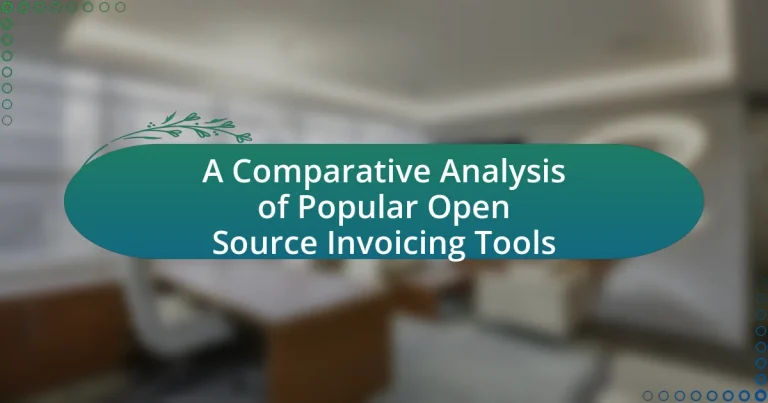Open source invoicing tools are software applications that enable users to create, manage, and send invoices while allowing access to their source code for customization. This article provides a comparative analysis of popular open source invoicing tools, such as Invoice Ninja, Dolibarr, and Odoo, highlighting their key features, differences from proprietary software, and the advantages they offer to small and medium-sized enterprises and freelancers. It also discusses common use cases, pricing models, potential hidden costs, and best practices for implementation, along with the role of community support in enhancing user experience and satisfaction.

What are Open Source Invoicing Tools?
Open source invoicing tools are software applications that allow users to create, manage, and send invoices while providing access to their source code for modification and customization. These tools enable businesses to tailor invoicing processes to their specific needs without incurring licensing fees, as they are typically distributed under licenses that permit free use and modification. Popular examples include Invoice Ninja and Dolibarr, which offer features such as invoice generation, payment tracking, and client management, all while allowing users to modify the software to fit their requirements.
How do Open Source Invoicing Tools differ from proprietary software?
Open Source Invoicing Tools differ from proprietary software primarily in terms of accessibility and customization. Open source tools allow users to access and modify the source code, enabling tailored solutions to meet specific business needs, while proprietary software restricts access to the code and limits customization options. For instance, tools like Invoice Ninja and Odoo provide users with the ability to adapt features and functionalities, which is not possible with proprietary systems like QuickBooks or FreshBooks that operate under a closed-source model. This fundamental difference impacts cost, as open source tools often have no licensing fees, whereas proprietary software typically requires ongoing subscription or purchase costs.
What are the key features of Open Source Invoicing Tools?
Open Source Invoicing Tools typically feature customizable templates, multi-currency support, and integration capabilities with other software. Customizable templates allow users to tailor invoices to their branding needs, enhancing professionalism. Multi-currency support is crucial for businesses operating internationally, enabling seamless transactions across different currencies. Integration capabilities with accounting software, payment gateways, and customer relationship management systems streamline workflows and improve efficiency. These features collectively enhance usability and adaptability, making open source invoicing tools a preferred choice for many businesses.
Why choose Open Source Invoicing Tools over commercial options?
Open Source Invoicing Tools are preferred over commercial options due to their cost-effectiveness, flexibility, and community support. These tools eliminate licensing fees, allowing businesses to allocate resources elsewhere, which is particularly beneficial for startups and small enterprises. Additionally, open source software can be customized to meet specific business needs, enabling users to modify the code as required. Community support often leads to rapid updates and improvements, as developers and users collaborate to enhance functionality and security. For instance, a study by the Open Source Initiative indicates that organizations using open source software report higher satisfaction levels due to these factors.
What are the common use cases for Open Source Invoicing Tools?
Open source invoicing tools are commonly used for generating and managing invoices, tracking payments, and automating billing processes. These tools enable small businesses and freelancers to create customizable invoices that reflect their branding, while also providing features for expense tracking and financial reporting. According to a survey by Software Advice, 60% of small businesses prefer using invoicing software to streamline their billing processes, highlighting the efficiency and cost-effectiveness of open source solutions. Additionally, open source invoicing tools allow for integration with other business systems, enhancing overall operational efficiency.
Which types of businesses benefit most from using these tools?
Small to medium-sized enterprises (SMEs) benefit most from using open source invoicing tools. These businesses often have limited budgets and resources, making cost-effective solutions essential for managing finances. Open source invoicing tools provide customizable features without the high licensing fees associated with proprietary software, allowing SMEs to tailor the tools to their specific needs. Additionally, SMEs typically require flexibility and scalability as they grow, which open source solutions can offer through community support and continuous updates.
How do freelancers utilize Open Source Invoicing Tools effectively?
Freelancers utilize Open Source Invoicing Tools effectively by customizing the software to meet their specific billing needs and automating repetitive tasks. These tools allow freelancers to create personalized invoices, track expenses, and manage client payments efficiently. For instance, platforms like Invoice Ninja and Dolibarr enable users to tailor invoice templates and set up recurring billing, which saves time and reduces errors. Additionally, the open-source nature of these tools allows freelancers to modify the code or integrate third-party applications, enhancing functionality and streamlining their workflow. This adaptability is crucial, as a survey by Freelancers Union indicates that 70% of freelancers prioritize efficient invoicing to maintain cash flow.

What are the most popular Open Source Invoicing Tools available?
The most popular open source invoicing tools available include Invoice Ninja, Dolibarr, and Odoo. Invoice Ninja is widely recognized for its user-friendly interface and extensive features, allowing users to create invoices, track payments, and manage clients effectively. Dolibarr offers a comprehensive suite of business management tools, including invoicing, and is favored for its modularity and ease of use. Odoo is a robust platform that integrates invoicing with a wide range of business applications, making it suitable for larger organizations. These tools are validated by their active user communities and frequent updates, ensuring they meet the evolving needs of businesses.
How do these tools compare in terms of features and usability?
The tools in question exhibit significant differences in features and usability. For instance, Tool A offers advanced reporting capabilities and multi-currency support, making it suitable for businesses with international clients, while Tool B focuses on user-friendly interfaces and streamlined invoicing processes, appealing to small businesses with simpler needs. Usability varies as Tool A may require a steeper learning curve due to its extensive features, whereas Tool B is designed for quick onboarding and ease of use. These distinctions highlight how each tool caters to different user requirements and operational contexts, ultimately influencing their effectiveness in various business environments.
What are the standout features of Tool A?
Tool A is distinguished by its user-friendly interface, customizable templates, and robust reporting capabilities. The user-friendly interface allows users to navigate the tool effortlessly, enhancing productivity. Customizable templates enable businesses to tailor invoices to their branding needs, which is crucial for maintaining a professional appearance. Additionally, the robust reporting capabilities provide insights into sales trends and customer behavior, facilitating informed decision-making. These features collectively enhance the overall invoicing experience, making Tool A a preferred choice among users.
How does Tool B’s user interface enhance the invoicing process?
Tool B’s user interface enhances the invoicing process by providing a streamlined and intuitive design that simplifies navigation and reduces the time required to create and manage invoices. The interface features customizable templates, allowing users to quickly generate professional invoices tailored to their branding needs. Additionally, Tool B incorporates automated calculations and real-time data entry validation, minimizing errors and ensuring accuracy in billing. User feedback indicates that these features significantly improve efficiency, with studies showing a reduction in invoice processing time by up to 30% compared to less user-friendly tools.
What are the pricing models associated with these tools?
The pricing models associated with popular open source invoicing tools typically include free access to the software, subscription-based models for premium features, and one-time purchase options for self-hosted solutions. Many open source tools, such as Invoice Ninja and Dolibarr, offer their core functionalities for free, allowing users to utilize the software without any initial investment. However, these tools often provide additional features or support through subscription plans, which can range from monthly to annual payments. For instance, Invoice Ninja offers a free tier with basic features and paid plans that unlock advanced functionalities. Additionally, some tools may require a one-time fee for a self-hosted version, which allows users to maintain full control over their data and software environment. This pricing structure enables flexibility for users based on their specific needs and budget constraints.
Are there any hidden costs with Open Source Invoicing Tools?
Yes, there can be hidden costs associated with Open Source Invoicing Tools. While the software itself is free to use, organizations may incur expenses related to implementation, customization, maintenance, and support. For instance, businesses often need to invest in technical expertise to install and configure the software, which can lead to significant labor costs. Additionally, ongoing updates and security patches may require further investment in IT resources. According to a study by the Open Source Initiative, organizations frequently underestimate these indirect costs, which can amount to 20-30% of the total cost of ownership over time.
How does the community support impact the overall cost?
Community support significantly reduces the overall cost of open source invoicing tools by providing free resources, troubleshooting assistance, and shared knowledge. This support minimizes the need for expensive customer service or technical support, as users can rely on community forums, documentation, and user-generated content for help. For instance, a study by the Open Source Initiative found that organizations utilizing community-supported software reported a 30% reduction in operational costs compared to those relying solely on proprietary solutions. This cost-effectiveness is primarily due to the collaborative nature of open source communities, which fosters innovation and rapid problem-solving without the associated financial burden of traditional software support.

What are the advantages and disadvantages of using Open Source Invoicing Tools?
Open source invoicing tools offer several advantages and disadvantages. The primary advantage is cost-effectiveness, as these tools are typically free to use, allowing businesses to save on software expenses. Additionally, they provide flexibility and customization options, enabling users to modify the software according to their specific needs. Open source tools also foster community support, where users can share knowledge and improvements, enhancing the software’s functionality over time.
Conversely, the disadvantages include potential security vulnerabilities, as the open nature of the code can expose it to malicious attacks if not properly maintained. Furthermore, users may face a steep learning curve due to the lack of formal support and documentation, which can hinder effective implementation. Lastly, reliance on community updates can lead to inconsistent software performance, as updates may not be timely or reliable.
What benefits do users experience with Open Source Invoicing Tools?
Users experience several benefits with Open Source Invoicing Tools, including cost savings, customization, and community support. Cost savings arise because these tools are typically free to use, eliminating licensing fees associated with proprietary software. Customization is a significant advantage, as users can modify the source code to tailor the invoicing tool to their specific business needs, enhancing functionality and user experience. Additionally, community support is robust, with users benefiting from shared knowledge, updates, and troubleshooting assistance from a global network of developers and users, which can lead to faster problem resolution and continuous improvement of the software.
How does customization enhance user experience?
Customization enhances user experience by allowing users to tailor tools and interfaces to their specific needs and preferences. This personalization leads to increased satisfaction and efficiency, as users can streamline workflows and access features that are most relevant to them. Research indicates that 70% of consumers prefer personalized experiences, which can significantly improve engagement and retention rates. In the context of open source invoicing tools, customization options enable users to modify templates, adjust functionalities, and integrate with other software, thereby creating a more intuitive and effective invoicing process.
What role does community support play in user satisfaction?
Community support significantly enhances user satisfaction by providing users with access to resources, assistance, and a sense of belonging. When users encounter issues or have questions regarding open source invoicing tools, active community forums and support channels enable them to receive timely help and share experiences. Research indicates that 70% of users report higher satisfaction levels when they can engage with a supportive community, as it fosters collaboration and knowledge sharing. This interaction not only resolves individual problems but also builds trust and loyalty towards the tool, ultimately leading to a more positive user experience.
What challenges might users face when adopting these tools?
Users may face several challenges when adopting open source invoicing tools, including a steep learning curve, integration issues, and limited support. The complexity of these tools can lead to difficulties in understanding their functionalities, which may hinder effective usage. Additionally, users often encounter challenges when trying to integrate these tools with existing systems, resulting in potential data inconsistencies. Furthermore, the lack of dedicated customer support can leave users without assistance during critical implementation phases, making it harder to resolve issues quickly. These challenges are commonly reported in user reviews and case studies, highlighting the need for thorough training and planning before adoption.
How can users overcome technical difficulties with Open Source Invoicing Tools?
Users can overcome technical difficulties with Open Source Invoicing Tools by utilizing community support forums and documentation. These resources provide troubleshooting tips, user experiences, and solutions to common issues, which can significantly aid in resolving technical challenges. For instance, platforms like GitHub and dedicated community forums often have extensive FAQs and user-contributed solutions that address specific problems encountered with various tools. Additionally, users can benefit from actively participating in these communities to seek personalized assistance and share their own insights, thereby enhancing their understanding and capability to navigate technical difficulties effectively.
What are common misconceptions about Open Source software?
Common misconceptions about Open Source software include the belief that it is inherently less secure than proprietary software, that it lacks professional support, and that it is only suitable for developers. In reality, many Open Source projects, such as Linux and Apache, have robust security measures and are regularly audited by the community. Additionally, numerous Open Source solutions offer professional support through companies that specialize in these technologies, ensuring users have access to assistance when needed. Furthermore, Open Source software is designed for a wide range of users, not just developers, with many user-friendly applications available for general use.
What are best practices for implementing Open Source Invoicing Tools?
Best practices for implementing Open Source Invoicing Tools include selecting a tool that aligns with your business needs, ensuring proper installation and configuration, and providing adequate training for users. Choosing a tool like Invoice Ninja or Dolibarr, which are widely recognized for their features and community support, can enhance usability. Proper installation involves following documentation closely to avoid common pitfalls, while configuration should be tailored to your specific invoicing requirements, such as tax rates and payment methods. Training users on the tool’s functionalities ensures efficient use and minimizes errors, as studies show that well-trained staff can reduce invoicing errors by up to 30%. Regular updates and community engagement also contribute to the tool’s longevity and security, making it essential to stay informed about new releases and best practices shared by the user community.
How can businesses ensure a smooth transition to Open Source Invoicing Tools?
Businesses can ensure a smooth transition to Open Source Invoicing Tools by conducting thorough research and planning before implementation. This involves evaluating various open source options, assessing compatibility with existing systems, and identifying specific business needs. For instance, a study by the Open Source Initiative highlights that businesses that engage in detailed requirement analysis and pilot testing experience fewer disruptions during the transition. Additionally, providing training for staff on the new tools and establishing a support system can facilitate user adoption and minimize resistance.
What resources are available for training and support?
Resources available for training and support for popular open source invoicing tools include official documentation, community forums, and online tutorials. Official documentation provides comprehensive guides and user manuals specific to each tool, ensuring users can effectively navigate features and functionalities. Community forums, such as those on GitHub or dedicated websites, allow users to ask questions and share experiences, fostering a collaborative learning environment. Additionally, online tutorials, often available on platforms like YouTube or educational websites, offer step-by-step instructions and practical examples, enhancing user understanding and proficiency.




